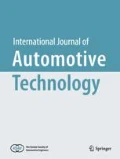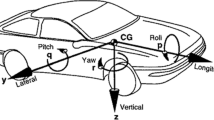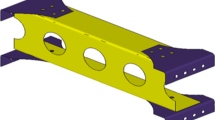Abstract
Torsion beam rear suspension systems have been widely used in small passenger vehicles. However, welding can lead to local stress concentrations, residual stresses and other various defects, which affects the fatigue life of this system. In this paper, 3D digital image correlation (DIC) technique was used to measure the weld region deformation of a torsion beam rear suspension system in the bench test. The test results show that the obvious strain concentration occurred at the welding seam under the cyclic loading. The numerical simulation work by finite element analysis (FEA) has been done to predict the fatigue damage of the torsion beam rear suspension system. The simulation results show that the location of the fatigue crack was at the strain concentration region in the test work. The enhancement test was performed on a proving ground. The fatigure crack location of the torsion beam rear suspension system in the test automobile was coincident with the results by DIC and FEA. If the load conditions of bench tests are close to the road test, DIC is a useful method to predict the fatigue damage by the strain concentration. As a in lab test it would reduce the cost of fatigue analysis.
Similar content being viewed by others
References
Barsoum, Z., Samuelsson, J., Jonsson, B. and Björkblad, A. (2012). Fatigue design of light weight welded vehicle structures-Influence of material and production procedures. Proc. Institution of Mechanical Engineers, Part B: J. Engineering Manufacture, 226,10, 1736–1744.
Blacha, L., Karolczuk, A., Banski, R. and Stasiuk, P. (2013). Application of the weakest link analysis to the area of fatigue design of steel welded joints. Engineering Failure Analysis, 35, 665–677.
Caminero, M. A., Lopez-Pedrosa, M., Pinna, C. and Soutis, C. (2013). Damage monitoring and analysis of composite laminates with an open hole and adhesively bonded repairs using digital image correlation. Composites Part B: Engineering, 53, 76–91.
Carroll, J. D., Abuzaid, W., Lambros, J. and Sehitoglu, H. (2013). High resolution digital image correlation measurements of strain accumulation in fatigue crack growth. Int. J. Fatigue, 57, 140–150.
Choi, B. L., Choi, D. H., Min, J., Jeon, K., Park, J., Choi, S. and Ko, J. M. (2009). Torsion beam axle system design with a multidisciplinary approach. Int. J. Automotive Technology, 101, 49–54.
Dong, P. (2001). A structural stress definition and numerical implementation for fatigue analysis of welded joints. Int. J. Fatigue, 2310, 865–876.
Fernandez, J. A. P., Coppieters, S. and Debruyne, D. (2016). Application of digital image correlation for the study of strain concentrations due to change in geometry in weld beads: Parent interface of structural steel welds. Science and Technology of Welding and Joining, 218, 670–679.
Finch, D. and Burdekin, F. (1992). Effects of welding residual stresses on significance of defects in various types of welded joint. Engineering Fracture Mechanics, 415, 721–735.
Kim, S. H. (2007). Tool design for the tubular press forming of a rear suspension member with the finite element analysis. J. Materials Processing Technology, 192-193, 181–187.
Kong, Y., Omar, M. Z., Chua, L. and Abdullah, S. (2014). Fatigue life prediction of parabolic leaf spring under various road conditions. Engineering Failure Analysis, 46, 92–103.
Lee, D. and Yang, C. (2013). An analytical approach for design and performance evaluation of torsion beam rear suspension. Finite Elements in Analysis and Design, 63, 98–106.
Li, G. Y., Xu, F. X., Sun, G. Y. and Li, Q. (2014). Identification of mechanical properties of the weld line by combining 3D digital image correlation with inverse modeling procedure. Int. J. Advanced Manufacturing Technology, 745-8, 893–905.
Lim, S. J. and Huh, H. (2017). Fracture loci of DP980 steel sheet for auto-body at intermediate strain rates. Int. J. Automotive Technology, 184, 719–727.
Mahadevan, S. and Ni, K. (2003). Damage tolerance reliability analysis of automotive spot-welded joints. Reliability Engineering & System Safety, 811, 9–21.
Niemi, E. (1995). Stress Determination for Fatigue Analysis of Welded Components. Woodhead Publishing. Sawston, Cambridge, UK.
Pan, B., Qian, K. M., Xie, H. M. and Asundi, A. (2009). Two-dimensional digital image correlation for in-plane displacement and strain measurement: A review. Measurement Science and Technology, 206, 152–154.
Park, N., Huh, H., Nam, J. B. and Jung, C. G. (2015). Anisotropy effect on the fracture model of DP980 sheets considering the loading path. Int. J. Automotive Technology, 161, 73–81.
Song, H. P., Zhang, H., Kang, Y. L., Huang, G. Y., Fu, D. H. and Qu, C. Y. (2013). Damage evolution study of sandstone by cyclic uniaxial test and digital image correlation. Tectonophysics, 608, 1343–1348.
Sutton, M. A., Matta, F., Rizos, D., Ghorbani, R., Rajan, S., Mollenhauer, D. H., Schreier, H. W. and Lasprilla, A. O. (2017). Recent progress in digital image correlation: Background and developments since the 2013 W M Murray lecture. Experimental Mechanics, 571, 1–30.
Zhao, L. H., Zheng, S. L. and Feng, J. Z. (2014a). Failure mode analysis of torsion beam rear suspension under service conditions. Engineering Failure Analysis, 36, 39–48.
Zhao, L. H., Zheng, S. L., Feng, J. Z., Zhou, H. F. and Xing, Y. F. (2014b). Fatigue assessment of rear axle under service loading histories considering the strengthening and damaging effects of loads below fatigue limit. Int. J. Automotive Technology, 155, 843–852.
Author information
Authors and Affiliations
Corresponding author
Rights and permissions
About this article
Cite this article
Zhan, N., Zhang, X., Jin, X. et al. Fatigue Analysis of Weld Region in Torsion Beam Rear Suspension System. Int.J Automot. Technol. 20, 247–253 (2019). https://doi.org/10.1007/s12239-019-0024-9
Received:
Revised:
Accepted:
Published:
Issue Date:
DOI: https://doi.org/10.1007/s12239-019-0024-9




